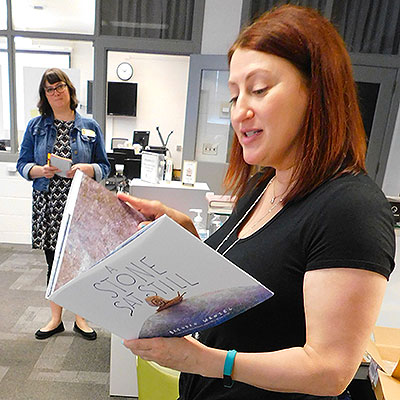
Melanie Koss donned a headpiece that gave her deer ears, reclined motionless on a couch in the Gabel Hall Learning Center, closed her eyes and played the role of a deceased doe.
And that wasn’t even the strangest sight at July’s NIU STEM Read Summer Institute.
Just one day later, participants created and wore costumes representing various high school cliques, dyed their hair with spray cans and fashioned makeshift totes from old newspapers and duct tape to race for groceries and other survival supplies dropped by an imaginary helicopter.
That these faux scavengers are mostly K-12 teachers and librarians demonstrates how much fun took place at the three-day professional development event.
Yet the simultaneous lessons – and the underlying intention of the workshop – support a serious cause: providing educators with a unique way to spark the imagination, curiosity, enthusiasm and engagement of young minds by bringing books to life.
Gillian King-Cargile and Kristin Brynteson, leaders of the STEM Read operation of NIU’s STEAM program, develop and deliver “gamified field trips” that explore and teach concepts of science, technology, engineering, math and even the arts – the “A” in “STEAM” – through activities tied to the plots of spellbinding books.
Educators who attend the Summer Institute not only become experts in staging these field trips on their own, at their own schools and districts, but also are given digital toolkits for STEM Read’s 2018-2019 events.
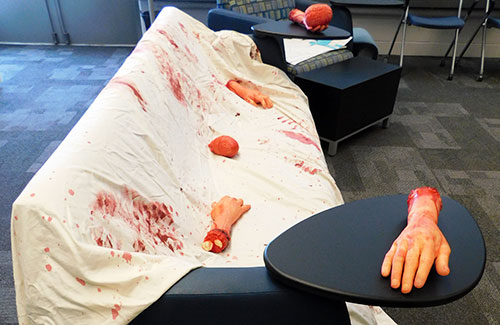 Titles include Kiersten White’s “The Dark Descent of Elizabeth Frankenstein,” Peter Brown’s “The Wild Robot,” Aaron Starmer’s “The Only Ones,” Lex Thomas’ “Quarantine: The Loners” and Lauren Tarshis’ “I Survived.”
Titles include Kiersten White’s “The Dark Descent of Elizabeth Frankenstein,” Peter Brown’s “The Wild Robot,” Aaron Starmer’s “The Only Ones,” Lex Thomas’ “Quarantine: The Loners” and Lauren Tarshis’ “I Survived.”
Koss, who as the NIU College of Education’s first Senior Faculty Fellow chose to partner with STEM Read, loves the power of the field trips to promote literacy, the building block of academic learning.
“Reading is obviously so important,” says Koss, an associate professor in the Department of Curriculum and Instruction.
But “when you’re in a classroom all day, and you’re with the same teacher and the same structure, no matter how engaging the teacher can be – and there are some amazing teachers – it can get repetitive and monotonous just because you’re going to the same place every single day, and the situation isn’t changing,” she adds.
“STEM Read field trips make learning engaging and exciting, and they’re different. Going on any field trip is a change of pace, but these are so authentic in terms of connecting literature to all of these different STEAM content areas.”
Dara Kappel, instructional technology specialist and a former fourth-grade teacher with Bensenville School District 2, would agree.
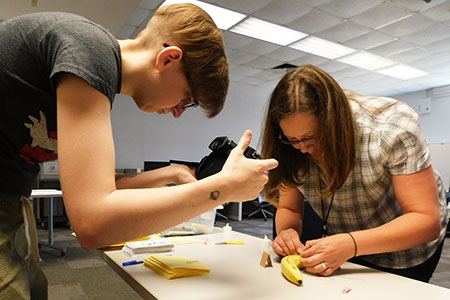
to stitch together Victor Frankenstein’s monster.
“I love the engagement factor for students,” says Kappel, a self-labeled “STEM Read groupie” and repeat customer of NIU’s Summer Institute.
“I came last year hoping to integrate it into my school this past year, and I did, for the first time. I did the ‘I Survived,’ ” she adds. “It was just amazing to me to see the students so passionate and so engaged in the learning. It really shows me that it’s something we need to incorporate in the curriculum.”
Fourth-graders collaborated on teams to solve the puzzles put before them, she says, but also sharpened a different skill.
“So many times our kids are used to their teachers giving them the answers,” she says. “This really helps them to become more independent learners.”
Kappel, who hopes to run a STEM Read event for Bensenville third-, fourth- and fifth-graders this year and then expand to middle school after that, learns the same way.
“To see the field trips run first-hand, and to actually participate in the challenges, is so much more beneficial than just hearing about it at a conference,” she says. “I really need to do it hands-on myself before I can teach it to students or other teachers. When you do it, you learn it better.”
Heather Johnson, district librarian for the Sterling Public Schools, became a STEM Read fan after coming to DeKalb for a field trip based on M.T. Anderson’s “Feed.”
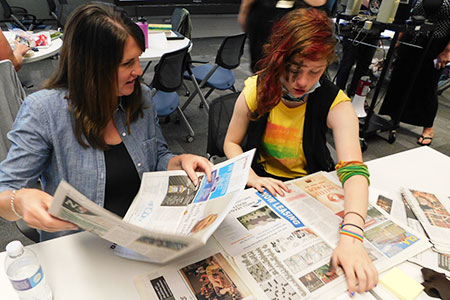 An English teacher at Sterling High School at the time, Johnson brought members of the SHS Library Club with her.
An English teacher at Sterling High School at the time, Johnson brought members of the SHS Library Club with her.
“We had to have walked out with our hair frazzled and our eyes huge. We had no idea what we were getting into,” she says. “That sparked in my kids, but also in me, to connect that literature with those complex opportunities for further exploration.”
For example, the “Elizabeth Frankenstein” games include the manufacture of a simple circuit that could, in the hypothetical fiction of the book, reanimate dead tissue. It’s not easy, of course, and many participants (adults included) require several attempts.
“So I didn’t figure out the circuit,” she says, speaking in the character of a K-12 student, “but maybe I want to go home and, gosh darn it, figure out how to get that circuit to work, because it’s going to bother me if I don’t.”
Conducting real science activities drawn from the dreamscapes of novels and children’s books also champions a “transdisciplinary approach” to education, Johnson says.
“Kids need to see that life is interconnected. Sometimes, they think in isolated subject areas, because that’s how we teach. The STEM Read model offers kids an opportunity to see that all of those subjects are really integrated,” she says.
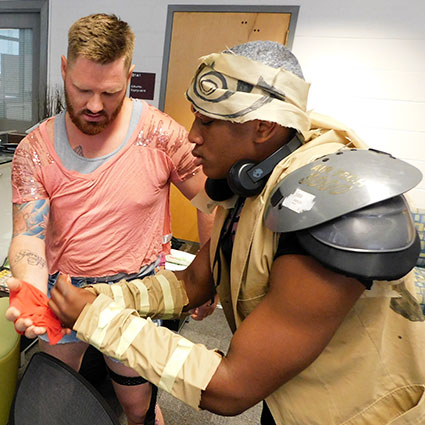
“If we are looking at ‘The Wild Robot’ as a piece of literature, that’s fantastic, and we do a really good job of looking at books as pieces of literature,” she adds, “but we’re not doing enough to explore the science or the methods behind some of what we’re asking our kids to do.”
Johnson also sees STEM Read “as a way to introduce a book, and then you’ve got buy-in from that kid who says, ‘Well, I’m not really a reader, but I was really interested in that game, and I was good at it, so maybe I’ll be good at reading this book, too.’ ”
Karrie Chajkowski, teacher librarian at Fort Thomas Independent Schools of Fort Thomas, Ky., came to DeKalb after seeing the enthusiasm of King and Brynteson as they presented their STEM Read model at the International Society for Technology in Education conference in Philadelphia.
Chajkowski already had read “The Wild Robot” to third-, fourth- and fifth-graders in Fort Thomas, and wanted to acquire the STEM Read knowhow and toolkit that would enable her to catapult the novel from its pages.
“It gets them involved. It lets them make a connection with a book. Kids are dying for that connection with a piece of literature that they can just get excited about,” she says. “There are so many times when I’ll be walking into school, and there are kids who are just waiting at my door because they finished one book and want the next one. I want that experience for all kids.”
She believes STEM Read also can “catch those kids who just fall through,” she adds, “to scoop them up and get them excited so they’ll go home and say, ‘Mom, Dad, Grandma, Grandpa’ –whoever they live with – ‘read this to me,’ to build those family connections and to build those kids’ connections and all of these positive interactions with teachers.”
Participating in the games herself demonstrated another valuable concept.
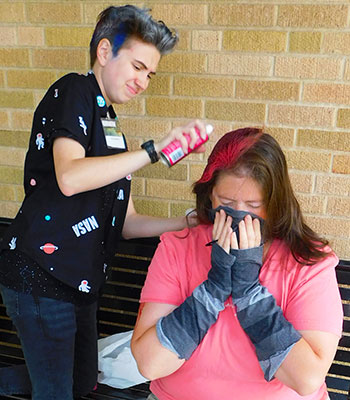
“These let the kids have a chance to ideate, to try and fail – they don’t get enough of that,” she says. “They see so much perfection that they feel like perfection should be instantaneous. They’re really good at playing school. They’re not really good at working out the problems and learning to try, and this gives them a great, safe environment to try.”
Johnson, who came to the STEM Read Institute in search of the confidence to present her own events in Sterling, now understands that “the book is irrelevant.”
“At first, I was really worried – ‘It’s got to be the right book, it’s got to be the right book’ – but I think that throughout the course of this time together, we’re learning that any book can be the right book if you can look creatively enough for an opportunity for learning, as long as you’re rooted in good science and you’re rooted in providing experiences for kids to try new things.”
She and her fellow participants were provided a front-row seat to, and allowed to join in, a brainstorming session between King, Brynteson and Koss regarding the STEM Read possibilities of “A Stone Sat Still” by Brendan Wenzel.
Within its pages and limited text – it’s a children’s book meant for ages 3 to 5 – the educators found concepts of climate change, observing nature, animal behavior, the four seasons, geology, the relativity of size and more.
Possible activities for a STEM Read event included art, such as changing colors or textures to alter the meaning of a message; painting and placing “kindness rocks” around the school; portraying the different animals that the stone sees; and asking children “to sit still and observe the behaviors around them” to understand the passage of time as well as their freedom to change with what they see or remain true to themselves.
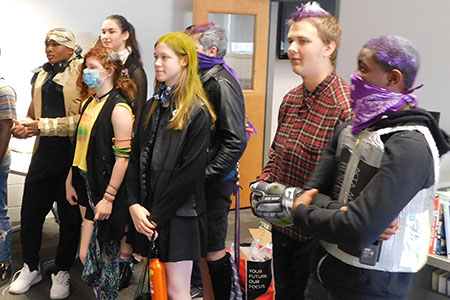 The spirited exchange “was fun to watch,” Johnson says.
The spirited exchange “was fun to watch,” Johnson says.
“They’re a slam-dunk team of individuals who’ve capitalized on a lot of different strengths and backgrounds to understand that, right now, there’s a deficit in STEM learning, especially in our elementary schools,” she says. “They understand that what’s best for kids isn’t always what we as educators are producing in our classrooms, and they’re challenging us in our thinking.”
Koss understands that reaction.
“We, as educators, don’t often get to participate in the activities we might be designing,” she says. “I think my favorite thing is watching the wheels turn in their own heads and those aha moments for them.”
In the end, she says, students reap the true rewards of the STEM Read Summer Institute and the local events it can yield.
“You’re allowed to have fun and be silly and be interactive, no matter where you fit into school. Are you the super-smart one? Are you the super-popular one? Are you someone who often causes trouble? Are you someone who struggles with reading?” Koss says.
“There are so many different challenges, and so many different ways that a child can shine if they are not mathematically inclined but they’re very good at engineering or art,” she adds. “Students can really find something to excel at during the day, and there’s a lot of self-validation in terms of being successful at doing a challenge.”


